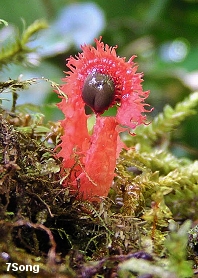| Major Groups > Stinkhorns > Laternea pusilla |

|
Laternea pusilla [ Basidiomycota > Agaricomycetes > Phallales > Clathraceae > Laternea . . . ] by Michael Kuo Here is a funky stinkhorn that is apparently limited to the Americas, from the Caribbean and Mexico southward. Like other stinkhorns it produces a spore-laden, foul smelling slime that attracts insects—but unlike any other species, it produces the slime on a specialized surface suspended between vaulted, crested, fringed arms. If you have seen The Lord of the Rings, this species is reminiscent of Sauron's Great Eye, suspended atop the evil tower, Barad-Dûr . . . except that Laternea pusilla is pink and tiny, maxing out at about 6 cm high, and the little tower sits peacefully in lush, green cloud forests instead of the desolation of Mordor. I have never collected Laternea pusilla, and I have never studied material collected by others. If you have found this amazing mushroom, I would love to make this page more scientific by studying your specimen! Please send me an email at if you would be interested in preserving the mushroom and sending it for study. Description: Ecology: Saprobic; growing alone or gregariously from moss-covered rotting wood or from forest debris near rotting wood; montane (4000-9000 feet); Mexico, Central America, the Caribbean, and South America; June through November. Immature Fruiting Body: A small, whitish "egg"; when sliced revealing the stinkhorn-to-be encased in a gelatinous substance. Mature Fruiting Body: A structure 2–6 cm high, composed of 2–3 (occasionally 4) unbranched, pinkish red to pink arms that are joined at the top in a corona-like arch. Arms: About 5 mm wide; in cross-section semicircular to circular; the edges prominently scalloped or, with maturity, tattered and fringed; spore slime dark brown, produced on a central, suspended structure under the apex of the arms; bases of arms free, but encased in a whitish volva; base attached to whitish or yellowish rhizoids. Microscopic Features: Spores 3–4 x 1–2 µm; cylindric; smooth; hyaline to yellowish. REFERENCES: Berkeley & Curtis, 1868. (Saccardo, 1888; Dring, 1980; López et al., 1982; Sáenz & Nassar, 1982; Sáenz et al., 1983; Calonge et al., 2004; Calonge et al., 2005; Trierveiler-Pereira et al., 2013; Trierveiler-Pereira, 2015.) I have not collected this mushroom. This site contains no information about the edibility or toxicity of mushrooms. |
© MushroomExpert.Com |
|
Cite this page as: Kuo, M. (2021, September). Laternea pusilla. Retrieved from the MushroomExpert.Com Web site: http://www.mushroomexpert.com/laternea_pusilla.html |
